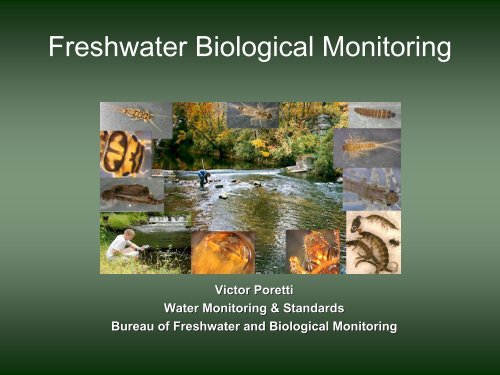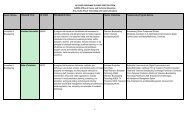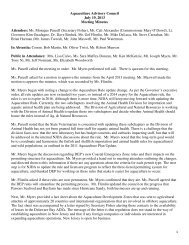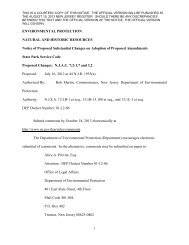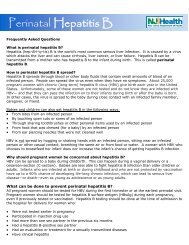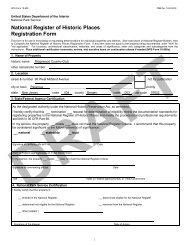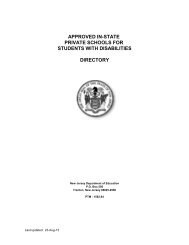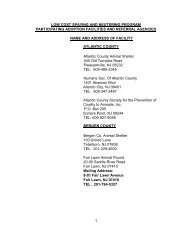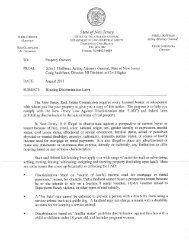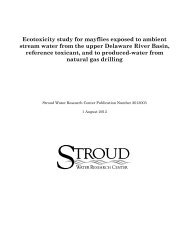Freshwater Biological Monitoring
Freshwater Biological Monitoring
Freshwater Biological Monitoring
Create successful ePaper yourself
Turn your PDF publications into a flip-book with our unique Google optimized e-Paper software.
<strong>Freshwater</strong> <strong>Biological</strong> <strong>Monitoring</strong><br />
Victor Poretti<br />
Water <strong>Monitoring</strong> & Standards<br />
Bureau of <strong>Freshwater</strong> and <strong>Biological</strong> <strong>Monitoring</strong>
WHY <strong>Biological</strong> <strong>Monitoring</strong>?<br />
<strong>Biological</strong> Indicators<br />
• Provide measures of biological<br />
condition that integrates<br />
chemical and physical stressors<br />
over larger spatial and temporal<br />
scales<br />
• Organisms are long-lived long lived and are<br />
therefore good indicators of long-<br />
term disturbances
WHY <strong>Biological</strong> <strong>Monitoring</strong>?<br />
• Ease of collection and identification<br />
• Of direct interest to the public as a<br />
measure of a pollution free<br />
environment
<strong>Biological</strong> Indicators<br />
At least 3 different principle<br />
indicators recommended<br />
• Benthic Macroinvertebrates<br />
�Sediment Toxicity Testing<br />
• Fish<br />
• Algae –Primary Productivity (as<br />
Chlorophyll “a”)<br />
Three necessary to integrate due to<br />
mobility and life history characteristics
Multi-metric Multi metric Index<br />
• Used for Macroinvertebrates and Fish<br />
• Scoring system based on multiple<br />
attributes (metrics) which measure<br />
community richness, pollution tolerance,<br />
and feeding groups<br />
• Metrics selected based on how well they<br />
indicate anthropogenic stressors<br />
• Individual metrics are aggregated into an<br />
index
Multi-metric Multi metric Index<br />
Index scores are<br />
assigned a rating<br />
which indicates<br />
impairment.<br />
•Excellent<br />
•Good<br />
•Fair<br />
•Poor
Ambient <strong>Biological</strong> <strong>Monitoring</strong> Network<br />
(AMNET)<br />
Benthic Macroinvertebrates<br />
3 Indices based on geographically different<br />
communities<br />
•HGMI– High Gradient Macroinvertebrate<br />
Index<br />
•CPMI– Coastal Plain Macroinvertebrate<br />
Index<br />
•PMI– Pinelands Macroinvertebrate Index
Methods
Mayfly<br />
Healthy Macroinvertebrate<br />
Community<br />
Beetle<br />
Caddisfly<br />
Stonefly
Leech<br />
Impaired Macroinvertebrate<br />
Aquatic worm<br />
Community<br />
Midge larva<br />
Aquatic Sowbug<br />
Black fly larva
Sediment Toxicity Test<br />
• Performed on sediments of AMNET sites<br />
which are severely impaired or had a<br />
significant drop in rating<br />
• Uses an in-house cultured amphipod as<br />
test organism<br />
• Can determine if toxicity is an impairment<br />
cause, rather than habitat degradation<br />
• Toxicity can occur even if SWQS are met
Methods
NJ Fish Index of Biotic Integrity<br />
(FIBI)
What is a Fish Index of Biotic Integrity?<br />
��Using Using fish assemblages to assess the<br />
overall health of a stream ecosystem<br />
��A A scoring system based on multiple<br />
attributes (metrics) of a fish assemblage<br />
��Individual Individual metrics are summed and<br />
overall score used to determine health<br />
of a water body<br />
��Metrics Metrics selected based on how well<br />
they indicate anthropogenic stressors
Program Objectives<br />
• Determine the current Status of fish<br />
communities, which reflect overall<br />
ecological integrity of the water<br />
resource.<br />
• Integrate Fish IBI with existing benthic<br />
macroinvertebrate environmental<br />
indicator.<br />
• Establish a routinely monitored network,<br />
so that Trends in ecological integrity<br />
can be determined.
Program Objectives (cont.)<br />
•Verify Compliance with primary goals<br />
of Clean Water Act<br />
• Evaluate the Causes of degraded water<br />
resources and the relative contribution<br />
of pollution sources.<br />
• Evaluate Effectiveness of restoration<br />
programs and control strategies.
Why Use Fish as <strong>Biological</strong> Monitors?<br />
�� Fish are long-lived long lived and are therefore good<br />
indicators of long-term long term disturbances<br />
�� Fish assemblages generally consist of a<br />
number of trophic levels<br />
�� Fish are at the top of the food chain in<br />
aquatic environments<br />
�� Fish are easy to collect and identify
Backpack Electrofishing<br />
Methods<br />
Barge Electrofishing
Methods<br />
Backpack Electrofishing
Healthy Fish Community<br />
Brook Trout<br />
Margined Madtom<br />
Swallowtail Shiner<br />
Cutlips Minnow<br />
Smallmouth Bass<br />
Satinfin Shiner<br />
Slimy Sculpin
Impaired Fish Community<br />
Mummichog<br />
White Sucker<br />
Green Sunfish<br />
Banded Killifish<br />
Common Carp
Fish IBI Network<br />
!( !(<br />
!( !(<br />
!( !(<br />
!(<br />
!(<br />
!( !( !(<br />
!(<br />
!( !(<br />
!( !(<br />
!( !(<br />
!( !( !(<br />
!( !(<br />
!( !(<br />
!( !( !( !(<br />
!(<br />
!( !(<br />
!(!( !(<br />
!(<br />
!(<br />
!(<br />
!( !(<br />
!(<br />
!(<br />
!( !(<br />
!( !( !( !( !(<br />
!( !(<br />
!(<br />
!( !(<br />
!(<br />
!( !( !(<br />
!(<br />
!(<br />
!(<br />
!(<br />
!(<br />
!(<br />
!( !(<br />
!( !( !( !(<br />
!( !( !( !( !( !(<br />
!( !(<br />
!(<br />
!(<br />
!( !( !( !( !(<br />
!(<br />
!( !( !( !( !( !(!( !(<br />
!(<br />
!(<br />
!( !(<br />
!( !( !(<br />
!(<br />
!(<br />
!( !(<br />
!( !( !(<br />
!( !(<br />
!(<br />
!(<br />
!(<br />
!(<br />
0 5 10± 20 30<br />
Miles<br />
!(<br />
!(<br />
!(<br />
!(<br />
!(<br />
!(<br />
!(<br />
!( !(<br />
!(<br />
!( !(<br />
!(<br />
!( !(<br />
!(<br />
!(<br />
!(<br />
!( !(<br />
!(<br />
!(<br />
!(<br />
!( !(<br />
!(<br />
!(<br />
!(<br />
!(<br />
!(<br />
!(<br />
!(<br />
Northern Fish IBI<br />
Pilot Sites
Chlorophyll “a”<br />
• Chlorophyll ‘a’ is the principle<br />
photosynthetic pigment and is common to<br />
all phytoplankton<br />
• Chlorophyll ‘a’ can thus be used as a<br />
measure of phytoplankton or algae<br />
biomass in lakes and other waterbodies.
Methods
www.state.nj.us/dep/wms//bfbm/


